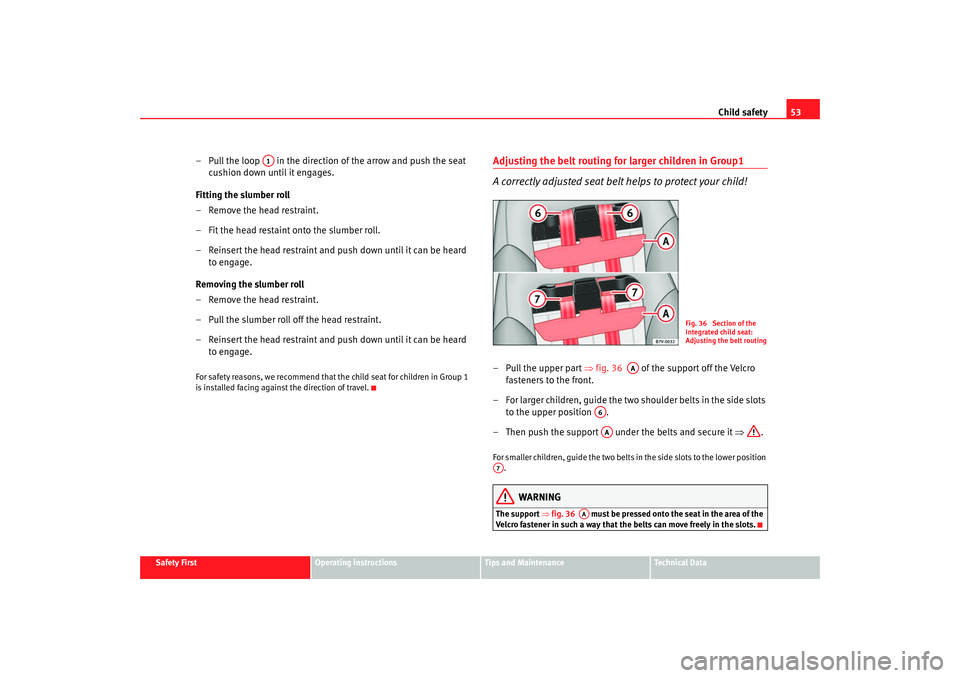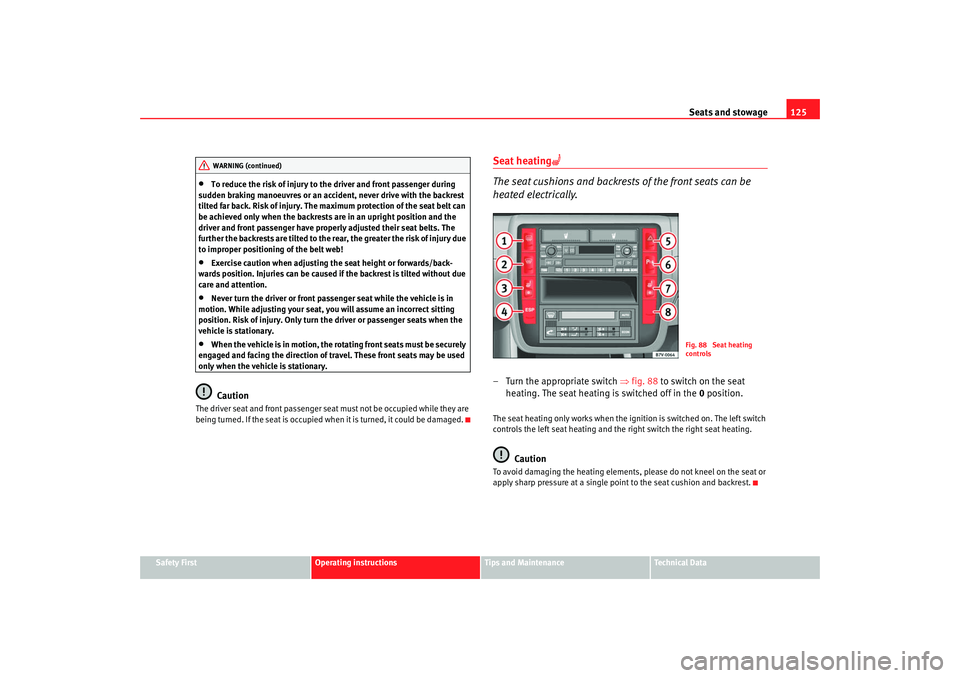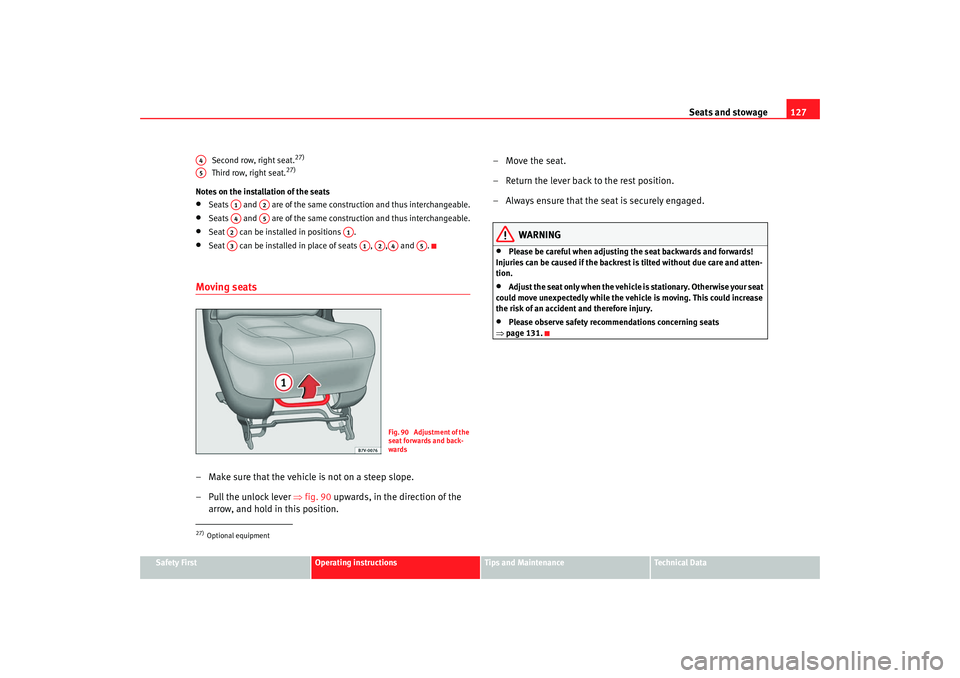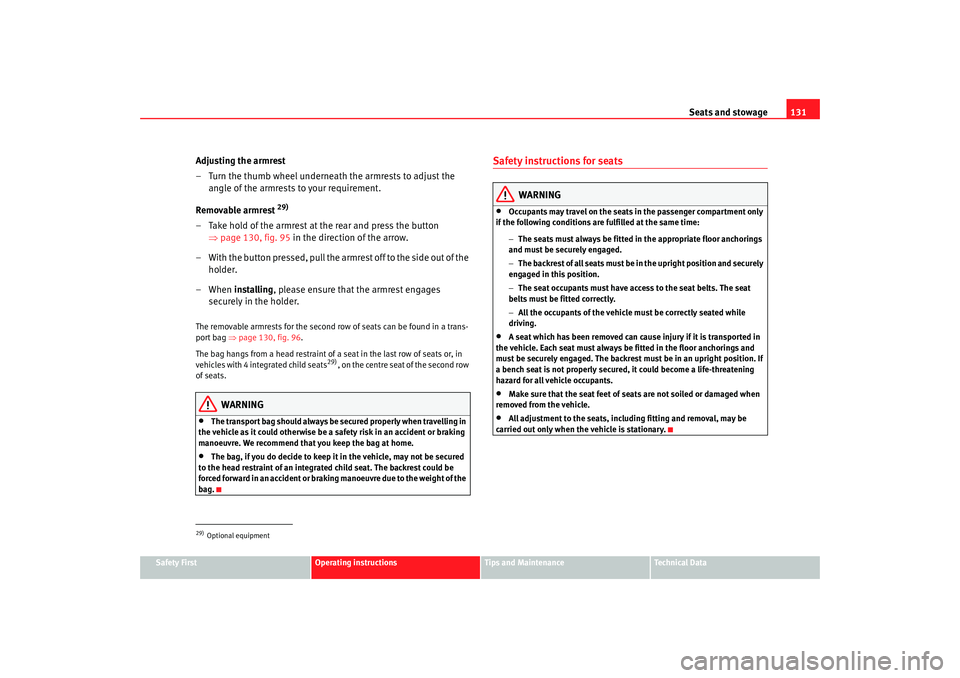2007 Seat Alhambra ECU
[x] Cancel search: ECUPage 55 of 291

Child safety53
Safety First
Operating instructions
Tips and Maintenance
Te c h n i c a l D a t a
– Pull the loop in the direction of the arrow and push the seat
cushion down until it engages.
Fitting the slumber roll
– Remove the head restraint.
– Fit the head restaint onto the slumber roll.
– Reinsert the head restraint and push down until it can be heard to engage.
Removing the slumber roll
– Remove the head restraint.
– Pull the slumber roll off the head restraint.
– Reinsert the head restraint and push down until it can be heard to engage.For safety reasons, we recommend that the child seat for children in Group 1
is installed facing against the direction of travel.
Adjusting the belt routing for larger children in Group1
A correctly adjusted seat belt helps to protect your child!–Pull the upper part ⇒ fig. 36 of the support off the Velcro
fasteners to the front.
– For larger children, guide the two shoulder belts in the side slots to the upper position .
–Then push the support unde r the belts and secure it ⇒.For smaller children, guide the two belts in the side slots to the lower position
.
WARNING
The support ⇒fig. 36 must be pressed onto the seat in the area of the
Velcro fastener in such a way that the belts can move freely in the slots.
A1
Fig. 36 Section of the
integrated child seat:
Adjusting the belt routing
AA
A6AA
A7
AA
alhambra ingles.book Seite 53 Donnerstag, 19. April 2007 4:04 16
Page 56 of 291

Child safety
54Fastening the harness belt for children in Group 1
A correctly adjusted seat belt helps to protect your child!
– Sit the child so that its bottom is as far back on the seat as
possible.
– Place the belt to the right and left over the childs' shoulders.
– Push the belt lock element ⇒fig. 37 with the tongue through
the other lock element .
– Insert both elements with the tongue at the front into the lock until they click into place. ( Pull to ensure they are securely
engaged! )
– Make sure that the protective cushion is always underneath the belt lock .
– Pull the upper part of the harness belt ⇒ fig. 38 down in the
direction of the arrow until the belt fits firmly against the body of
the child.
WARNING
The harness belt must always fit firmly against the body of the child (even
with thick or winter clothing) so that the child seat can provide the
maximum amount of protection possible.
Fig. 37 Section of inte-
grated child seat: Harness
belt lockFig. 38 Section of inte-
grated child seat: Harness
belt adjustment
AB
AC
AD
AE
AD
A1
alhambra ingles.book Seite 54 Donnerstag, 19. April 2007 4:04 16
Page 98 of 291

Unlocking and locking
96
– Press button ⇒ page 93, fig. 61 to fold out the key bit.
– Use the lock on the driver door to unlock the vehicle. The anti- theft alarm system remains active, but an alarm is not triggered
immediately.
– Switch on the ignition within 15 seconds. When the ignition is switched on, the electronic immobiliser recognises a valid
vehicle key and deactivates the anti-theft alarm system. If you do
not switch on the ignition within 15 seconds, the alarm is trig-
gered.The anti-theft alarm makes it more diffi cult to break into the vehicle or steal
it. Audible and visible alarms
13) are triggered if the car is opened using the
mechanical key, or if unauthorised access is gained to the vehicle.
When does the system trigger an alarm?
The system triggers an alarm if the following unauthorised actions are carried
out when the car is locked:
•
Opening of vehicle using mechanical key without switching on ignition
within the next 15 seconds
•
Opening a door
•
Opening the bonnet
•
Opening the tailgate
•
Switching on the ignition
•
Movement inside the vehicle (in vehicles with interior monitoring).
The horn sounds and the indicators flash for approx. 30 seconds. Interior monitoring system
The sensors for the interior monitoring system are located at the top of the
door post between the front and rear door
⇒page 95, fig. 62 The sensors
must not be covered, as they will otherwise not be able to function properly.
The windows must be closed when the interior monitoring system is active as
the anti-theft alarm could be triggered by a draft of air.
Note
•
If, after the alarm goes off, access is gained to a second secured zone
(e.g. the tailgate is opened after a door has been opened), the warning signal
is triggered again.
•
Vehicle monitoring remains active even if the battery is disconnected or
not working for any reason.
13)Optional equipment
A3
alhambra ingles.book Seite 96 Donnerstag, 19. April 2007 4:04 16
Page 100 of 291

Unlocking and locking
98Driving with the tailgate open
If the tailgate is open or incorrectly closed, the following warning may be
appear on the display
14). Please note that theft of your cargo is more likely if
the tailgate is open.
WARNING
If you have to drive with the tailgate open, please observe the following
warnings:•
Observe the following points to reduce the danger of poisoning from
exhaust fumes entering the vehicle interior:
−Close all windows.
− Close the sliding/tilting roof,
− Switch off air recirculation.
− Open the air outlets in the dash panel,
− Set the fresh air blower to the highest speed.
•
Drive particularly carefully and think ahead. If possible, avoid sudden
braking and driving manoeuvres as this could cause the open tailgate to
move unpredictably. Risk of injury.
•
When carrying objects that protrude from the boot, the correct signals
should be used; otherwise there is a risk of accident. Observe legal require-
ments when doing so.
•
Always secure objects in the boot. Loose items could fall out of the
vehicle and injure other road users.
•
If a baggage rack is fitted on the tailgate, it should be removed before
travelling with the tailgate open.
•
Read and always observe the safety information concerning the use of
the tailgate ⇒ page 99.
Closing the tailgateBefore closing the tailgate, make sure that the key has not been left
inside the boot.
Closing the tailgate
– Take hold of the grip in the inside trim of the tailgate ⇒ and
pull the tailgate down.
–Pull hard.A display appears in the combi-instrument if the tailgate is not properly
closed
15).WARNING
Always close the tailgate properly. Risk of accident or injury.•
Do not close the tailgate by pushing it down with your hand on the
window. The glass could shatter. Risk of injury!
•
Ensure the tailgate is locked after cl osing. If not, it may open unexpect-
edly while driving.
•
Never allow children to play in or around the vehicle. A locked vehicle
can be subjected to extremely high and low temperatures, depending on
the time of year. This could cause serious injuries/illness. It could even
have fatal consequences. Close and lock both the tailgate and all the other
doors when you are not using the vehicle.
•
Never close the tailgate without observing and ensuring it is clear, to do
otherwise could cause serious injury to you and others. Make sure that no
one is in the path of the tailgate.
15)Optional equipment
alhambra ingles.book Seite 98 Donnerstag, 19. April 2007 4:04 16
Page 125 of 291

Seats and stowage123
Safety First
Operating instructions
Tips and Maintenance
Te c h n i c a l D a t a
Removing or adjusting head restraints
The head restraints can be adju sted by moving them up and
down.Adjusting height
– Hold the side of the head restraint.
– Push the head restraint up (in the direction of the arrow) or push
it down with the button pressed ⇒ fig. 86 (arrow). Correct setting
⇒ page 122.
– Make sure that the head restraint engages securely in position.
Removing the head restraint
– Push the head restraint up as far as it will go.
– Press the button ⇒fig. 86 -arrow-. – Pull head restraint out of fitting without releasing the button.
Fitting the head restraint
– Insert the head restraint into the guides on the rear backrest.
– Press and hold button ⇒
fig. 86 (arrow) and push the head
restraint down as far as it will go .
– Adjust the head restraint to suit body size.
WARNING
Never drive if the head restraints have been removed. Risk of injury.•
After refitting the head restraint, you must always adjust it properly for
height to achieve optimal protection.
•
Please observe the safety warnings ⇒page 122, “Correct adjustment
of head restraints”.
Fig. 86 Adjusting and
removing the head
restraints
alhambra ingles.book Seite 123 Donnerstag, 19. April 2007 4:04 16
Page 127 of 291

Seats and stowage125
Safety First
Operating instructions
Tips and Maintenance
Te c h n i c a l D a t a
•
To reduce the risk of injury to the driver and front passenger during
sudden braking manoeuvres or an accident, never drive with the backrest
tilted far back. Risk of injury. The maximum protection of the seat belt can
be achieved only when the backrests are in an upright position and the
driver and front passenger have properly adjusted their seat belts. The
further the backrests are tilted to the rear, the greater the risk of injury due
to improper positioning of the belt web!
•
Exercise caution when adjusting the seat height or forwards/back-
wards position. Injuries can be caused if the backrest is tilted without due
care and attention.
•
Never turn the driver or front passenger seat while the vehicle is in
motion. While adjusting your seat, you will assume an incorrect sitting
position. Risk of injury. Only turn the driver or passenger seats when the
vehicle is stationary.
•
When the vehicle is in motion, the rotating front seats must be securely
engaged and facing the direction of travel. These front seats may be used
only when the vehicle is stationary.Caution
The driver seat and front passenger seat must not be occupied while they are
being turned. If the seat is occupied when it is turned, it could be damaged.
Seat heating
The seat cushions and backrests of the front seats can be
heated electrically.– Turn the appropriate switch ⇒fig. 88 to switch on the seat
heating. The seat heating is switched off in the 0 position.The seat heating only works when the ignition is switched on. The left switch
controls the left seat heating and the right switch the right seat heating.
Caution
To avoid damaging the heating elements, please do not kneel on the seat or
apply sharp pressure at a single point to the seat cushion and backrest.
WARNING (continued)
Fig. 88 Seat heating
controls
alhambra ingles.book Seite 125 Donnerstag, 19. April 2007 4:04 16
Page 129 of 291

Seats and stowage127
Safety First
Operating instructions
Tips and Maintenance
Te c h n i c a l D a t a
Second row, right seat.
27)
Third row, right seat.
27)
Notes on the installation of the seats•
Seats and are of the same construction and thus interchangeable.
•
Seats and are of the same construction and thus interchangeable.
•
Seat can be installed in positions .
•
Seat can be installed in place of seats , , and .
Moving seats – Make sure that the vehicle is not on a steep slope.
– Pull the unlock lever
⇒fig. 90 upwards, in the direction of the
arrow, and hold in this position. –Move the seat.
– Return the lever back to the rest position.
– Always ensure that the seat is securely engaged.
WARNING
•
Please be careful when adjusting the seat backwards and forwards!
Injuries can be caused if the backrest is tilted without due care and atten-
tion.
•
Adjust the seat only when the vehicl e is stationary. Otherwise your seat
could move unexpectedly while the vehicle is moving. This could increase
the risk of an accident and therefore injury.
•
Please observe safety recommendations concerning seats
⇒ page 131.
27)Optional equipmentA4A5
A1
A2
A4
A5
A2
A1
A3
A1
A2A4
A5
Fig. 90 Adjustment of the
seat forwards and back-
wards
alhambra ingles.book Seite 127 Donnerstag, 19. April 2007 4:04 16
Page 133 of 291

Seats and stowage131
Safety First
Operating instructions
Tips and Maintenance
Te c h n i c a l D a t a
Adjusting the armrest
– Turn the thumb wheel underneath the armrests to adjust the
angle of the armrests to your requirement.
Removable armrest
29)
– Take hold of the armrest at the rear and press the button ⇒page 130, fig. 95 in the direction of the arrow.
– With the button pressed, pull the armrest off to the side out of the
holder.
–When installing , please ensure that the armrest engages
securely in the holder.The removable armrests for the second row of seats can be found in a trans-
port bag ⇒page 130, fig. 96.
The bag hangs from a head restraint of a seat in the last row of seats or, in
vehicles with 4 integrated child seats
29), on the centre seat of the second row
of seats.
WARNING
•
The transport bag should always be secured properly when travelling in
the vehicle as it could otherwise be a safety risk in an accident or braking
manoeuvre. We recommend that you keep the bag at home.
•
The bag, if you do decide to keep it in the vehicle, may not be secured
to the head restraint of an integrated child seat. The backrest could be
forced forward in an accident or braking manoeuvre due to the weight of the
bag.
Safety instructions for seats
WARNING
•
Occupants may travel on the seats in the passenger compartment only
if the following conditions are fulfilled at the same time:
−The seats must always be fitted in the appropriate floor anchorings
and must be securely engaged.
− The backrest of all seats must be in the upright position and securely
engaged in this position.
− The seat occupants must have access to the seat belts. The seat
belts must be fitted correctly.
− All the occupants of the vehicle must be correctly seated while
driving.
•
A seat which has been removed can cause injury if it is transported in
the vehicle. Each seat must always be fitted in the floor anchorings and
must be securely engaged. The backrest must be in an upright position. If
a bench seat is not properly secured, it could become a life-threatening
hazard for all vehicle occupants.
•
Make sure that the seat feet of se ats are not soiled or damaged when
removed from the vehicle.
•
All adjustment to the seats, incl uding fitting and removal, may be
carried out only when the vehicle is stationary.
29)Optional equipment
alhambra ingles.book Seite 131 Donnerstag, 19. April 2007 4:04 16